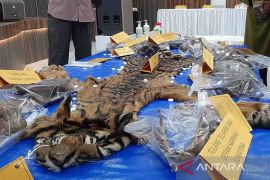The Sumatran tiger was given special treatment at the Attica Zoo on World Animal Day, an international awareness day aimed at spotlighting the cruel treatment of animals by humans, to support the rights of animals on a global basis, and to treat them like living creatures and not as products or things.
The inauguration of the Sumatran tiger exhibit was led by Indonesias Ambassador to Greece in the presence of students from Byron College, environmentalists, animal lovers, friends of Indonesia, and the visitors to Attica Zoo.
John Admiral, First Secretary of the Indonesian Embassy in Athens, stated that the inauguration of exhibit in conjunction with the World Animal Day will help boost public awareness and education about protecting critically endangered animals.
Protecting critically endangered animals, including the Sumatran tiger, is necessary for creating a safe and comfortable world for all animals.
The Sumatran tiger is classified as a critically endangered animal by the International Union for the Conservation of Nature (IUCN), which said that the tiger is the face of Asias biodiversity and an emblem of the worlds natural heritage.
IUCN President Ashok Khosla stated that the international trade in tigers and tiger parts is universally illegal, and it must be stopped immediately.
The countries of origin or destination of such trade must enforce their laws with utmost rigor.
He noted that action to save the tiger must be launched now, so that next year, which has been declared as the Year of the Tiger, efforts begin to ensure that the tiger's world is not in a crisis, but can become a symbol of celebration and a model of success.
To raise awareness and love for the animals, as well as knowledge about the Sumatran tiger, visitors to the Attica Zoological Park were given a brochure and an explanation about the diversity of the endemic fauna of Indonesia and the characteristics of the Sumatran Tiger.
The pair of Sumatran tigers in Attica Zoo was brought from zoos in Sweden and France through the European Endangered Species Program (EEP), which manages the development of the population of endangered animals.
Currently, there are only 122 Sumatran tigers in zoos in Europe, and therefore, the development of its population has become one of the main programs of the EEP.
In Indonesia, the landscape is critical for the long-term survival of Sumatran tigers as it serves as both a tiger source site and a critical corridor for tiger movement across the region.
Rampant poaching, coupled with the opening of massive plantation areas and forest fires, has led to a continued drop in the number of protected Sumatran tigers.
The Sumatran tiger is one of the last remaining tiger species in Indonesia after the Balinese and Javanese tiger species were declared extinct, but now, its existence remains under threat because its habitat has shrunk and it is being hunted for trading.
Environment and Forestry Ministry (KLHK) officials recently apprehended two men in possession of a Sumatran tiger's skin in the Indragiri Hulu District, Riau Province, according to Security and Law Enforcement Center for Environment and Forests spokesman Edward Hutapea.
He stated that the two men are known by their initials as AH (51) and JO (35). The intact Sumatran tiger skin they were carrying was seized as evidence.
After a two-week coordination effort between the KLHK, Jambi Natural Resources Conservation Agency, and the World Wildlife Fund (WWF) and reconnaissance in Jambi, the officials apprehended the duo for illegally possessing the Sumatran tiger skin.
WWF said there is still a substantial market in Asia for tiger parts and products.
Both actors are still being questioned as witnesses, but it is possible that their status will be upgraded as suspects if the investigators find any evidence of criminal activity.
The confiscated Sumatran tiger skin was some two meters long and was intact, with no defects from head to tail, indicating that the poachers were professionals.
A South Sumatran police team had also caught a man named Suharno alias Reno, a trader in Lubuklinggau city, South Sumatra, earlier this year.
When Suharno was caught, he was in possession of a tiger skin that was 120 centimeters long in a plastic bag containing preservatives and some tiger bones weighing two kilograms.
The man claimed he receive these parts from a tiger hunter in Jambi.
An intact tiger skin can be sold between Rp50 million and Rp100 million, depending on its size and condition.
Suharno was later sentenced by the district court of Palembang to six months in jail while he could have been given a maximum sentence of five years and fined Rp100 million, based on Law Number 5 of 1990 on Ecosystem and Conservation of Living Natural Resources.
However, Animals Indonesia, a social community institution for animal conservation, deplored the fact that the Palembang district court meted out a light sentence to Suharno, the man involved in the tiger skin trade.
For Animals Indonesia, the light sentencing of Suharno was very disappointing because the defendant was clearly proven to be indulging in trading skin and bones of the Sumatran tiger, a species falling under the protected animal category.
Therefore, every effort must be made to raise public awareness of wildlife protection after many large mammals, such as Sumatran tigers are killed each year, their tusks hacked out, and their bodies left to rot.
Public awareness must also be raised to curb the illicit trade involving wild animals and their products, which is currently the worlds fifth largest business, with a turnover of US$19 billion each year.(*)
Reporter: Otniel Tamindael
Editor: Heru Purwanto
Copyright © ANTARA 2016











